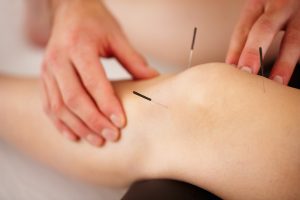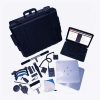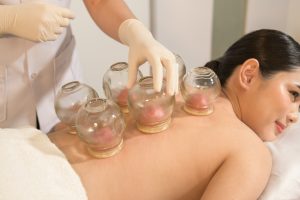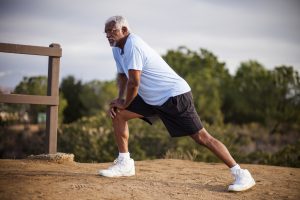
Get to the Point: Debunking Misconceptions About Dry Needling
Treatment GuidelinesDry needling is a manual technique that's rapidly growing in popularity. Unfortunately, so are common misbeliefs about this popular treatment. Today we're setting the record straight and getting to the point of dry needling.
Dry needling is a manual technique performed by licensed medical professionals that has shown an explosion in popularity over the past 10 years. Prior to its clinical use, researchers including the late Janet Travell, came across its utility while studying treatment options for myofascial trigger points. Interestingly, the term dry needling came about because it served as a placebo treatment contrasted against analgesic injections. With several misconceptions floating through the recovery community, today we’re setting the record straight and getting to the point of dry needling.
What is dry needling?
If you’re a practicing clinician in the outpatient setting, you’ve likely experienced, performed or at least heard of dry needling. For those not as familiar, dry needling is an invasive procedure performed by medical professionals to reduce myofascial pain. It has been used clinically since the 1980s but a recent increase in evidence has expanded its application for a variety of patient populations.1 The procedure involves inserting a solid filament needle into the skin and muscle, aimed directly at a myofascial trigger point. These trigger points are taut bands of skeletal muscle located within a larger muscle group. Clinically, trigger points can be active or latent and contribute to both local and referred pain.
Accurately identifying myofascial trigger points relies heavily on effective palpation skills. To find a trigger point, palpate perpendicular to the muscular fiber direction and feel for tissue densities. Active trigger points are physiological contractures characterized by local ischemia and hypoxia, a significantly lowered pH, a chemically altered milieu, local and referred pain and altered muscle activation patterns.2 Latent trigger points are less irritable but can cause tenderness and referred pain upon palpation. Pain elicited by either of these trigger points can be a problem in and of itself or can compound other conditions.
As many of us have seen clinically, dry needling can be extremely effective. Thanks to growing evidence and increased access to certification courses, this treatment is now a commonplace tool in many of our toolkits. Unfortunately, with the increase in treatment popularity, the spread of false information related to the treatment has also expanded. Ready to sift through the fiction and uncover the facts? Let’s jump right in.
#1: Dry needling is the same as acupuncture
Perhaps the biggest misconception about dry needling is that it is the same as acupuncture. While territorial battles persist, the only true similarity between the interventions is the tool with which they’re are performed. Where trigger points are present, dry needling works to release the muscular contraction and improve the local tissue environment. It is based on muscular palpation and our strong knowledge of anatomy and established muscular referral patterns.
Conversely, acupuncture is a technique used in eastern medicine that has been around for thousands of years and works to restore natural energy flow through the system as a whole. Both use a solid monofilament needle to complete the treatment but vary significantly in their treatment goals, philosophies, and indications for use.
#2: Dry needling is covered by Medicare
False again. Although the CPT codes 20560 and 20561 were assigned by CMS to dry needling procedures in 2020, they remain non-covered. According to CMS guidelines, dry needling is not covered unless otherwise specified through a national determination. So what does this mean for practicing clinicians? Given that these codes are not reimbursed, we must turn to advocacy initiatives and explore alternative payment options to get paid for our skilled services. To learn more about running a cash-based practice, read this article: How to Power a Fully Cash-pay Clinic with Evidence-based Neck Treatment.
#3: Dry needling is a stand-alone procedure
Similar to all other PT interventions, dry needling is a single tool in our toolkit and rarely will be effective if performed as a stand-alone procedure. As you’ve seen with many patients, treating the symptoms without treating the cause will often lead to re-injury or recurrence. To be most successful, complement dry needling with manual interventions, neuromuscular re-education, therapeutic exercise, and patient education.
#4: Dry needling is only appropriate for myofascial pain syndrome
Whether or not you’ve received a prescription for “myofascial pain”, a large portion of your patients likely have some pain contribution from myofascial components. Problems are rarely isolated to one specific structure, but instead a complex and interconnected relationship between various regions, tissues and components. It’s not surprising that research has identified the presence of trigger points in a variety of common diagnoses including:
- Radiculopathies
- Joint dysfunction
- Disk pathology
- Tendonitis
- TMJ dysfunction
- Cervicogenic / tension headaches
- Carpal tunnel syndrome
- Pelvic Pain
- Fibromyalgia
- Whiplash associated disorders
- Acute muscular strains
While treatment of these conditions can and should be addressed from a variety of therapeutic standpoints standard in your daily practice, research shows that dry needling is an effective inclusion in many cases.
#5: Dry needling involves the injection of medication
Dry needling is as its name indicates – dry. No medication is injected during the procedure. Injecting any medication, commonly analgesics, is a different procedure called wet needling.
While dry needling can be performed by Chiropractors or Physical Therapists among others, wet needling can only be performed by trained Physicians, Physician Assistants or Nurse Practitioners.
Specific rules and regulations regarding prescription necessities and billing procedures vary state by state but the actual procedure of dry needling stays the same. Each session should begin with a systems review and informed consent. Using clinical judgment and preliminary palpation, you will identify targeted muscle groups. After cleaning with a sanitizing wipe, the muscle is palpated for taut bands with the goal of reproducing the patient’s “familiar pain pattern.”
Once identified, the monofilament needle is inserted into the trigger point and pistoned with the appropriate depth and technique. A twitch response may be felt and is correlated with reduced spontaneous electrical activity and local acetylcholine at the trigger point.2 In simpler terms, I often tell patients it flushes local pain products and releases tissue tightness. Regardless of treatment location or clinical experience, it’s essential to educate your patients about treatment expectations, potential risks and likely benefits.
#6: Dry needling comes without contraindications
As effective as dry needling can be, this final statement is also false. Similar to any invasive procedure, there are certainly populations in which dry needling is contraindicated. This includes patients with severe needle phobia, over an area with lymphedema, those who are experiencing a medical emergency, and those who are unable to give consent for communication, cognition, or age-related reasons.2
Relative contraindications include post-op status of less than 12 weeks, diabetes, healing deficiencies, autoimmune disorders, pregnancy, and patients on blood thinners. Use your clinical judgment, practice within your training, educate your patients appropriately, and you will be set up for a success.
The bottom line: when pain arises from myofascial trigger points, dry needling can be an effective modality to release muscular contraction and relieve symptoms. With many misconceptions floating through our community, it’s important that we set the record straight and educate others appropriately. While ongoing research will continue to clarify appropriate indications for use, staying abreast of advocacy initiatives will ensure our scope of practice is maintained.
Morgan Hopkins, DPT, CMTPT
Morgan Hopkins, DPT, CMTPT is a Physical Therapist and freelance healthcare writer. She spent over eight years treating patients in outpatient orthopedics before transitioning to medical writing. Her clinical specialties include intramuscular dry needling, dance medicine, and sports medicine. Morgan is extremely passionate about holistic wellness, preventative care and functional fitness and uses writing to educate and inspire others. To get in touch with Morgan, visit her LinkedIn or Upwork pages.
References
- Liu, Q. G., Liu, L., Huang, Q. M., Nguyen, T. T., Ma, Y. T., & Zhao, J. M. (2017). Decreased Spontaneous Electrical Activity and Acetylcholine at Myofascial Trigger Spots after Dry Needling Treatment: A Pilot Study. Evidence-based complementary and alternative medicine : eCAM, 2017, 3938191. https://doi.org/10.1155/2017/3938191
- Unverzagt, C., Berglund, K., & Thomas, J. J. (2015). DRY NEEDLING FOR MYOFASCIAL TRIGGER POINT PAIN: A CLINICAL COMMENTARY. International journal of sports physical therapy, 10(3), 402–418






